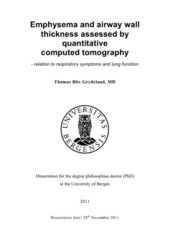| dc.contributor.author | Grydeland, Thomas Blix | en_US |
| dc.date.accessioned | 2012-02-03T10:22:26Z | |
| dc.date.available | 2012-02-03T10:22:26Z | |
| dc.date.issued | 2011-11-28 | eng |
| dc.identifier.isbn | 978-82-308-1882-4 (print version) | en_US |
| dc.identifier.uri | https://hdl.handle.net/1956/5543 | |
| dc.description.abstract | Aims: 1 – To quantify emphysema (%LAA, percentage Low Attenuation Areas) and airway wall thickness (AWT-Pi10, Airway Wall Thickness in a standardized airway with an internal perimeter of 10 mm) in ever-smoking COPD and non-COPD subjects using quantitative CT analysis, and to determine how these anatomic measures varied with gender, age and smoking habits. 2 – To describe the relationship between respiratory symptoms of COPD and quantitative CT measures of emphysema and airway wall thickness, and to assess how these relationships interacted with COPD-status, gender, age and smoking history. 3 – To examine the relationship between the diffusing capacity of the lung and quantitative CT measures of emphysema and airway wall thickness, and to assess how these relationships varied by COPD status, gender, age and smoking history. Methods: The subjects included in the current study were all participants in the GenKOLS study, and constitute the approximate half of the GenKOLS population that received an optional CT scan. A total of 463 COPD subjects (65 % men) and 488 non-COPD subjects (53 % men) were included in this study. In paper I we excluded 57 non-COPD subjects (volunteers) from the analyses, and in paper III we excluded 175 COPD subjects and 63 non-COPD subjects from the analyses due to missing or invalid DLCO measurements. All included subjects were current or ex-smokers older than 40 years. They underwent spirometry (Vitalograph 2160), diffusing capacity tests (SensorMedics Vmax22D) and CT examination (GE LightSpeed Ultra), and completed multiple questionnaires, including an ATS questionnaire on respiratory symptoms. The CT images were quantitatively assessed (Emphylx-J software), giving indices on lung density and airway dimensions. Results: 1 – Median (25, 75-percentile) %LAA was 8.9 (2.8, 19.1) and 4.7 (1.5, 15.5) in male and female COPD subjects, and 0.71 (0.32, 1.58) and 0.32 (0.14, 0.84) in male and female non-COPD-subjects. %LAA was higher in ex-smokers and increased with increasing age and with increasing number of pack years. Mean (SD) AWT-Pi10 (mm) was 5.04 (0.30) and 4.74 (0.31) in male and female COPD subjects, and 4.88 (0.28) and 4.63 (0.25) in male and female non-COPD subjects. AWT-Pi10 decreased with increasing age in cases, and increased with the degree of current smoking in all subjects. 2 – Both %LAA and AWT-Pi10 were independently and significantly related to the level of dyspnea among COPD subjects, even after adjustments for FEV1 in % predicted. AWT-Pi10 was significantly related to cough and wheezing in COPD subjects, and to wheezing in non-COPD subjects. Odds ratios (95% confidence limits) for increased dyspnea in COPD subjects and non-COPD subjects was 1.9 (1.5, 2.3) and 1.9 (0.6, 6.6) per 10 % increase in %LAA, and 1.07 (1.01, 1.14) and 1.11 (0.99, 1.24) per 0.1 mm increase in AWT-Pi10, respectively. 3 – Multiple linear regression analyses showed significant associations between DLCO and both %LAA and AWT-Pi10 in the COPD group. The adjusted regression coefficients (SE) for DLCO were -1.15 (0.11) mmol · min-1 · kPa-1 per 10% increase in %LAA and 0.08 (0.03) mmol · min-1 · kPa-1 per 0.1 mm increase in AWT-Pi10, and the adjusted R2 of the models were 0.65 and 0.49, respectively. Conclusions: 1 – There were significant differences between COPD and non-COPD subjects in quantitative CT measures of emphysema and airway wall thickness. Gender, age and smoking history also had strong effects on these quantitative CT measures and must be considered when comparing quantitative CT studies. 2 – Quantitative CT measures of emphysema and airway wall thickness were significantly and independently associated with respiratory symptoms, and may be used to explain the presence of respiratory symptoms beyond the information offered by spirometry. 3 – Quantitative CT measured emphysema was highly related to both diffusing capacity and diffusing coefficient in COPD subjects, and this relationship was even stronger in men. There was also a positive, but not equally strong, relation between CT measured airway wall thickness and diffusing capacity, and this was contrary to our hypothesis that there would be no relationship between airways and diffusing capacity. Both CT measures provide valuable information about the lungs not readily available from spirometry and diffusing capacity alone, but the modest explained variation attributable to the airway measurements warrants further studies. | en_US |
| dc.language.iso | eng | eng |
| dc.publisher | The University of Bergen | eng |
| dc.relation.haspart | Paper I: Grydeland TB, Dirksen A, Coxson HO, Pillai SG, Sharma S, Eide GE, Gulsvik A, Bakke PS. Quantitative computed tomography: emphysema and airway wall thickness by sex, age and smoking. European Respiratory Journal 34(4):858-65, October 2009. Full text not available in BORA due to publisher restrictions. The article is available at: <a href="http://dx.doi.org/10.1183/09031936.00167908" target="blank"> http://dx.doi.org/10.1183/09031936.00167908</a> | en_US |
| dc.relation.haspart | Paper II: Grydeland TB, Dirksen A, Coxson HO, Eagan TM, Thorsen E, Pillai SG, Sharma S, Eide GE, Gulsvik A, Bakke PS. Quantitative computed tomography measures of emphysema and airway wall thickness are related to respiratory symptoms. American Journal of Respiratory and Critical Care Medicine 181(4):353-9, February 2010. Full text not available in BORA due to publisher restrictions. The article is available at: <a href="http://dx.doi.org/10.1164/rccm.200907-1008OC" target="blank"> http://dx.doi.org/10.1164/rccm.200907-1008OC</a> | en_US |
| dc.relation.haspart | Paper III: Grydeland TB, Thorsen E, Dirksen A, Jensen R, Coxson HO, Pillai SG, Sharma S, Eide GE, Gulsvik A, Bakke PS. Quantitative CT measures of emphysema and airway wall thickness are related to DLCO. Respiratory Medicine 105(3):343-51, November 2011. Full text not available in BORA due to publisher restrictions. The article is available at: <a href="http://dx.doi.org/10.1016/j.rmed.2010.10.018" target="blank"> http://dx.doi.org/10.1016/j.rmed.2010.10.018</a> | en_US |
| dc.title | Emphysema and airway wall thickness assessed by quantitative computed tomography - relation to respiratory symptoms and lung function | en_US |
| dc.type | Doctoral thesis | |
| dc.rights.holder | Copyright the author. All rights reserved | |
| dc.subject.nsi | VDP::Medical disciplines: 700::Clinical medical disciplines: 750::Lung diseases: 777 | eng |

